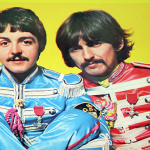First in an occasional series on marketing to boomers and an aging population.
Yesterday and today
When the Beatles released their Sgt. Pepper album with the classic song “When I’m 64,” boomer heartthrob Paul McCartney was about the same age as Taylor Swift is today.
Sir Paul turned 72 in June, and the first boomers are turning 68. As time marches on, boomers are getting up there. (Full disclosure, I was born smack dab in the middle of the baby boom. You can do the math.) This huge demographic bulge, sometimes called “the pig in the python,” is still 76 million strong. Today it controls more than half of consumer spending, not to mention 80+% of personal financial assets.
By size and wealth, boomers still merit our attention as marketers—and will for years to come. It’s a terrific opportunity, but what are we doing about it? (Besides, of course, featuring a few studly guys with gray hair winking at their slightly younger female partners in Cialis ads.)
Technology and its discontents
Business is obsessed with technology, from the hot new smartphone to Facebook’s jaw-dropping $19 billion purchase of WhatsApp. Heard the buzz about startup A? When’s the IPO for B? With D out now, is C dead? Speculation abounds on the Next Big Thing. Understandable perhaps, as fortunes will be made or lost. But much of it feels like either playground chatter or Las Vegas.
Tech is big in Boston, and I regularly find myself in conversations with tech entrepreneurs. I often wonder if I’m on another planet. When I ask some variation on the question, “How does this touch people’s lives?” I tend to get blank stares. Sometimes I get huffing and puffing. It usually takes a while to get a cogent answer. On rare, delightful occasions, I get a passionate and compelling story.
The gizmo guys
Engineering, in some form, drives most technology these days. And while some engineers have dazzling insight and creativity, overall they’re off-the-chart left-brainers, narrowly focusing on the known. No wonder: engineering takes gobs of sequential, logical, analytical thinking. Mastery of established, compartmentalized knowledge. Lots of math.
The left brain is terrific at dealing with what’s abstract, isolated, and static. But it doesn’t understand real, individual human beings and their actual lives, which is the province of the right brain. Nor does it scan for the big picture and the unexpected.
When we’re 74…or 84
Boomers are a bridge generation: we use plenty of technology, but we don’t necessarily delight in it. Few of us are early adopters. Digital natives (including our young adult kids) shake their heads at our slowness to adopt the latest and greatest, our inability to master the obvious. My own threshold for tech frustration is low and laughable.
From a decade of caring for three aging parents, my husband and I know this: old age doesn’t mellow. It tends to sharpen what’s already there.
Years hence, some youth-obsessed boomers may well surround themselves with piles of new gadgets to appear cool. But most boomers use technology primarily as a means to an end. We just want what it lets us do. Few linger to admire the whiz-bangery along the way.
As we age, we’ll be less and less interested in what’s simply new. We’ll be more focused on what makes a genuine difference in our lives, less patient with what gets in the way. Upgrades will leave us cold, if not inspire genuine dread.
Who’s thinking about the impact this will have on a massive industry built on novelty, change, and new releases? Probably not the masters of Silicon Valley.
A golden (years) opportunity
As boomers age, we’ll continue to buy and use technology, but we’ll be more demanding. A right-brain perspective sees this as a terrific opportunity.
Mature adults’ indifference to novelty-for-novelty’s sake can guide the drive for genuine innovation that brings meaningful change to real people’s lives. Our irritation with silly upgrades can foster better corporate discipline. Our impatience with opaque instructions can fuel better design that works for everyone.
A few years ago, a close friend and her adult siblings gave their father an iPad for his 90th birthday. It was a gamble: would he use it, or would it sit in a box? He took to it immediately, not just because he is an awesome 90+year-old (though he is). It allowed him to do things he cared about with ease, like reading the NYTimes and connecting with his grandchildren.
Right-brain expertise can help ensure that new products and services are more than mere technical wonders. A whole-brain approach, coupling right-brain insight with left-brain wizardry, will help create not only what can be done, but what should be done—and what will delight young and old alike.




